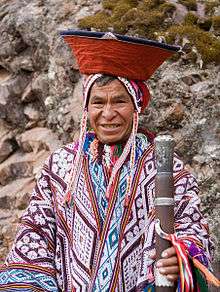Folk costume

| Part of a series on |
| Costume |
|---|
 |
|
Background
|
|
Society and culture |
|
Elements and methods |
|
Children |
|
Fictional |
|
Organizations |
|
People
|
|
Museums
|
A folk costume (also regional costume, national costume, or traditional garment) expresses an identity through costume, which is usually associated with a geographic area or a period of time in history. It can also indicate social, marital and/or religious status. Such costumes often come in two forms: one for everyday occasions, the other for festivals and formal wear.
Following the outbreak of romantic nationalism, the peasantry of Europe came to serve as models for all that appeared genuine and desirable. Their dress crystallised into so-called "typical" forms, and enthusiasts adopted that attire as part of their symbolism.
In areas where Western dress codes have become usual, traditional garments are often worn at special events or celebrations; particularly those connected with cultural traditions, heritage or pride. International events may cater for non-Western attendees with a compound dress code such as "business suit or national dress".
In modern times, there are instances where traditional garments are required by sumptuary laws. In Bhutan, the traditional Tibetan-style clothing of gho and kera for men, kira and toego for women, must be worn by all citizens, including those not of Tibetan heritage. In Saudi Arabia, women are also required to wear the abaya in public.
Africa
Central Africa
- Cameroon – Pagne (female), Toghu (male)
- Democratic Republic of the Congo – Pagne
- Gabon – Pagne
- Republic of the Congo – Pagne
- São Tomé and Príncipe – Pano
Eastern Africa
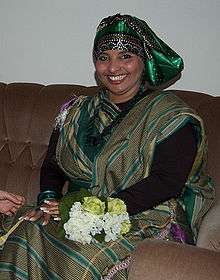
- Burundi – Imvutano
- Comoros – Lesso (female), Kanzu (male)
- Djibouti – Macawiis (male), Koofiyad (male), Dirac (female), Garbasaar (female)
- Eritrea – Kidan Habesha (male), Zuria or Habesha kemis (female)
- Ethiopia – Ethiopian suit or Kidan Habesha (male), Habesha kemis (female)
- Kenya – Kenya is unique among African nations in that it is the only country that does not have a national costume. All tribes have their respective traditional garments, for example: Maasai traditional costume: Kitenge, Kikoi, Maasai beadwork
- Rwanda – Mushanana
- Madagascar – Lamba
- Somalia – Macawiis (male), Koofiyad (male), Dirac (female), Guntiino (female), Garbasaar (female)
- Tanzania – Kanzu and Kofia (male), Kanga (female)
- Uganda – Kanzu and Kofia (male), Gomesi (female)
Northern Africa
- Algeria : Binouar (Sétif), Bikhmar (Ouargla), Blouza (Oran), Burnous (Algérie), Caftan (Algérie), Caftan El-Bey (Algérie), Chemsa (Jijel), Fergani (Constantine), Gandoura (Algérie), Gandoura Annabiya (Annaba), Ghlila (Algiers), Haïek (Algérie), Jellaba (Algérie), Karakou (Algiers), Kachabia (Djelfa et Laghouat), Labsa Kbaylia (Kabylie), Labsa M'zabia (M'zab), Labsa Naïlia (Ouled Naïl), Labsa Touratia (Hoggar), Lefa we dlala (Annaba), Melhfa Chaouïa (Aures), Melhfa Sahraouia (Tindouf), Mlaya (Algérie), Sarouel (Algérie), Sarouel Mdawer (Algiers)
- Egypt – Galabeya
- Libya – Jellabiya, Farmla (an embroidered vest), Fouta
- Morocco – Djellaba, Fez hat and Balgha (male), Takchita (female)
- Sahrawi Arab Democratic Republic – Darra'a (male), Melhfa Sahraouia (female)
- Sudan – Jalabiyyah, Taqiyyah, and Turban (male), Toob, a cotton women's dress (female)
- Tunisia – Jebba, Chechia, Fouta
Southern Africa
- South Africa – Afrikaners and British diaspora: slouch hat, safari shirt, veldskoen khaki Bermuda shorts; Zulus, Xhosa, etc.: Madiba shirt, shweshwe clothing, Zulu crown (isicholo)
- Angola – Pano
- Malawi – Chitenje
- Lesotho – Shweshwe clothing and blankets, Mokorotlo
- Mozambique – Capulana
- Namibia – Herero traditional clothing
- Zambia – Chitenje
- Zimbabwe – Safari shirt (male), Chitenje (female)
Western Africa

- Benin – lace Dashiki suit and Aso Oke Hat (male), lace Buba and wrapper set (female)
- Burkina Faso – Batakari (male), Kaftan (female)
- Cape Verde – Pano de terra
- Côte d'Ivoire – Kente cloth (male), Kente kaba and slit set (female)
- Gambia – Boubou (male), Kaftan (female)
- Ghana – Kente cloth or Ghanaian smock and Kufi (male), Kente kaba and slit set (female)
- Guinea – Boubou (male), Kaftan (female)
- Guinea-Bissau – Boubou (male), Kaftan (female)
- Liberia – Dashiki suit and Kufi (male), Buba and skirt set (female)
- Mali – Grand boubou and Kufi (male), Kaftan (female)
- Mauritania – Darra'a (male), Melhfa Sahraouia (female)
- Niger – Babban riga, Tagelmust, Alasho (male), Kaftan (female)
- Nigeria – Agbada, Dashiki or Isiagu and Aso Oke Hat (male), Buba and wrapper set (female)
- Senegal – Senegalese kaftan and Kufi (male), Kaftan (female)
Asia
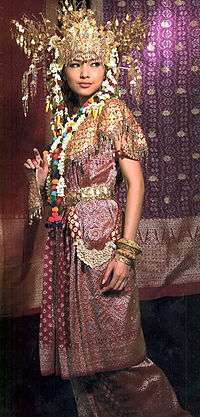
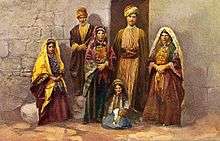


Central Asia
- Kazakhstan – Chapan
- Turkmenistan – Chapan
- Tuva – Deel
- Uzbekistan – Khalat, Tubeteika
Eastern Asia
- China – Hanfu, Cheongsam, Tangzhuang
- Tibet – Chuba
- Inner Mongolia – Deel
- Japan – Kimono, Junihitoe, Sokutai
- Korea – Hanbok
- Mongolia – Deel
- Taiwan – Similar to China. Also, all aboriginal tribes have a distinct tribal costume.
Southern Asia
- Afghanistan – Pashtun dress: Afghan cap, turban, Shalwar Kameez (male), Firaq partug, Chador (veil) (female)
- Bangladesh – Kurta (male) and Sari (female)
- Bhutan – Gho (male) and Kira (female)
- India – Achkan, Dhoti, Kurta (male) and Sari (female)
- Maldives – Dhivehi libaas (women) Sarong, white shirt (men)
- Nepal – Daura-Suruwal, (male) and Gunyou Cholo (female); Traditional Newar clothing
- Pakistan – Peshawari pagri, Shalwar Kameez, Churidar (male), Shalwar Kameez and Dupatta (female)
- Sri Lanka – Mul Anduma (men), Ossariya (women)
Southeastern Asia
- Brunei – Baju Melayu (male), Baju Kurung, Tudung (female)
- Cambodia – Sampot, Apsara, Sabai, Krama, Chong kraben
- East Timor – Tais cloth clothing
- Indonesia – (See: National costume of Indonesia). Every ethnic group in the country has their national costume. Kebayas, sarongs and the Beskap jacket of the Javanese and the Kain batik and dance costumes of Bali are some examples.
- Laos – xout lao, suea pat, pha hang, pha biang, sinh
- Malaysia – Baju Melayu and Songkok (male), Baju Kurung, Baju Kebarung (Kebaya/Kurung hybrid), Tudung (female)
- Myanmar – Longyi, Gaung baung
- Philippines – Barong Tagalog (male) and Maria Clara gown (female)
- Singapore – Baju Lokchuan (male) and Nyonya Kebaya (female)
- Thailand – chut thai: Thai female: Thai Chakkri, Thai male: Suea Phraratchathan, Both genders: chong kraben and sabai.
- Vietnam – Áo giao lĩnh, Áo dài, Áo tứ thân, Áo bà ba.
Western Asia
- Abkhazia – Chokha
- Armenia – Each region has its own style of folk costume.
- Azerbaijan – Azerbaijani traditional clothing
- Bahrain - Thawb
- Georgia – Chokha (Every region has its own specific design of Chokha)
- Israel – Tembel hat, Biblical sandals, Yemenite Jewish clothes; Jewish religious clothing: Rekel, Bekishe, Tzitzit, Kippah, Tichel.
- Iran –Chador, Turban, Khalat, Azerbaijani traditional clothing, Assyrian clothing, Kurdish clothing
- Iraq – Assyrian clothing, Keffiyeh, Bisht, Kurdish clothing, Dishdasha
- Jordan – Keffiyeh, Bisht, Bedouin clothing
- Lebanon – Tantour, Keffiyeh, Taqiyah
- Kurdistan – Sirwal (pants), Kurdish clothing, gold coin belt and necklace for women.
- Kuwait - Thawb
- Oman – Dishdasha
- Ossetia – Chokha
- Qatar - Kandura
- Palestine – Keffiyeh, Taqiyah (cap), Palestinian costumes.
- Saudi Arabia – Thawb, Ghutrah, Agal, Bisht, Abaya, Jilbab, Niqab
- Syria – Dishdasha
- Turkey – Fez, Kaftan, Shalvar.
- United Arab Emirates – Kandura
- Yemen – Similar to Saudi Arabia, but with the addition of an ornate jambiya and leather bandoliers for the men's costume.
Europe
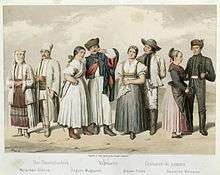
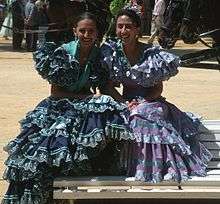
Eastern Europe
- Belarus – Slutsk stash, the national type of wimple (namitka)
- Bulgaria – Every town has its own design of a national costume (nosia), with different types of clothing items traditional for each of the ethnographic regions of the country.[1][2]
- Romania – Romanian dress
- Russia – Sarafan, Kokoshnik, Kosovorotka, Ushanka, Valenki; (Sami) Gákti, Luhkka for colder weather
- Chechnya – Chokha, Taqiyah (cap), Ushanka in cold weather
- Ukraine – National costumes of Ukraine: Vyshyvanka, Sharovary, Żupan, Ukrainian wreath
Central Europe
- Poland – Żupan, Kontusz, Rogatywka (National costumes of Poland)
- Czech Republic – Kroje
- Hungary – National costumes of Hungary
- Slovakia – Kroj (embroidered traditional dress)
Northern Europe
- Denmark – Folkedragt
- Finland – Every region has its own specific design of national costume (kansallispuku, nationaldräkt). (Sami) Gákti, Luhkka for colder weather
- Iceland – Þjóðbúningurinn
- Ireland – Aran sweater, Irish walking hat, Grandfather shirt, Leine
- Norway – Bunad; (Sami) Gákti, Luhkka for colder weather
- Sweden – Sverigedräkten has varied from region to region but since 1983 is the official National Costume in one common version; 18th century: Nationella dräkten; (Sami) Gákti, Luhkka for colder weather
- United Kingdom:
- England – English Country Clothing, Morris dance costumes.
- London – Pearly kings and queens.
- Cornwall – Sou'wester hat, fisherman's smock, bal-maiden clothing; see also Culture of Cornwall and Cornish kilts and tartans.
- Northern England: Flat caps and wooden English clogs originally worn by the miners and mill workers but now associated with clog dancing.
- Northern Ireland: Similar to Ireland.
- Scotland – Highland dress: Kilt or trews, tam o'shanter or Balmoral bonnet, doublet, Aboyne dress, and brogues or ghillies.
- Wales – Traditional Welsh costume
- England – English Country Clothing, Morris dance costumes.
Southern Europe
- Albania – Albanian Traditional Clothing
- Andorra – Barretina, espadrilles
- Croatia – Croatian national costume, Lika cap, Sibenik cap
- Greece – Fustanella, Amalia costume; Ancient Greek clothing: Peplos, Chiton
- Italy – Italian folk dance costumes; Roman clothing: Toga, Stola
- Kosovo – Traditional clothing of Kosovo
- Macedonia – Macedonian national costume
- Malta – Għonnella (Faldetta)
- Montenegro – Montenegrin cap
- Serbia – Serbian dress, Šajkača, Opanci
- Portugal – Every region has its own specific design of a national costume.
- Slovenia – Gorenjska noša (Upper Carniola)
- Spain – Every autonomous region has its own national costume.
Western Europe
- Austria – Tracht and Dirndl
- Belgium – Bleu sårot
- France – Beret, Breton costume, Sabot, Breton shirt, Alsatian costume
- Germany – Every region has its own specific design of a national costume. For example, Bavaria's well-known Tracht: Lederhosen and Dirndl.
- Liechtenstein – Tracht, Dirndl
- Netherlands – Dutch cap, Klompen; poffer (North Brabant)
- Switzerland – Every canton has its own specific design of a national costume.
North America
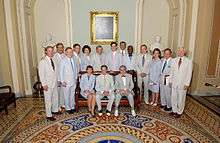

Caribbean
- Cuba – Guayabera, panama hat (male), "bata cubana"[3] (female)
- Dominican Republic – Chacabana (male), "Cultivo de la vida" (dress) (female)
- Dominica – Madras
- Haiti – Karabela dress (female), Shirt jacket (male)
- Jamaica – Madras-cloth Quadrille dress (female), Madras shirt and white trousers (male)
- Puerto Rico – Guayabera, panama hat (male), "Enaguas" (dress) (female)
- St. Lucia – Madras
- Trinidad and Tobago – Shirt jacket (male), Booboo (female)
Central America
- Guatemala – Huipil, Corte skirt, Tocado (female), Todosantero suit (male)
- Nicaragua – Huipil, Rebozo (female), Sombrero, white shirt and trousers (male)
- Panama – Pollera (female), Montuno (male)
Northern America
- Bermuda – Bermuda shorts
- Canada:
- Mexico – Charro suit, Sarape, Sombrero (male), Rebozo, China Poblana dress (female); every state has a typical folk dress, for example:
- United States:
- American West, Southwestern US and Midwestern US – Western wear, derived from original American pioneer garb is traditional dress in Texas, the Southwestern US, and many rural communities, including cowboy hats, Western shirts, cowboy boots, jeans, prairie skirts, and bolo ties.
- American Upper Midwest, the northern portions of the Great Lakes Basin and Maine. Due to the cold weather the garb in rural areas tends to more closely adhere to heavier materials, such as flannel, the occasional parka, and trapper hat. A good example is seen in the typical attire of Paul Bunyan, a folk hero popular in areas where logging was a common occupation.
- Southern US – Traditional Southern US wear includes white seersucker suits and string ties for men, and sun hats and large Southern belle-style dresses for women.
- Northeastern US – According to folklorist Washington Irving, knickerbockers similar to the breeches of the Pilgrims and Founding Fathers were traditionally worn by many wealthy Dutch families in 19th century New York. These short pants remained commonplace among young urban American boys until the mid 20th century.
- Nantucket – Summer residents of Nantucket will often wear Nantucket Reds.
- Amish (in Pennsylvania, Indiana and Ohio), the Pennsylvania Dutch and some sects of Mormon fundamentalism (especially in Utah) preserve traditional 19th century clothing styles.
- Moccasins, buckskins, glass beads, breech clouts, and war bonnets are traditional pow-wow regalia for Plains Indians.
- Alaska – kuspuks, worn with dark pants and mukluks, as well as parkas are traditional native wear.
Oceania
Australia and New Zealand
- Australia – European Australians: Bushwear: Khaki trousers, Akubra, Driza-Bone, Australian work boots; Aborigines: Aboriginal Australian tribal dress, lap-lap, fibercraft-made clothing, possum cloak
- New Zealand – Māori Flax Skirts
Melanesia
- Fiji – Sulu, Tapa cloth
- New Caledonia – Manou, Robes mission
- Papua New Guinea – Meri blaus, lap-lap
- Vanuatu – Kustam dress
Polynesia
- Cook Islands – Pareo
- French Polynesia – Pareo
- Hawaii – Aloha shirt, Muumuu
- Samoa – Lavalava, Puletasi, 'ie toga clothing
- Tonga – Tupenu, Ta'ovala, Tapa cloth
South America
- Argentina – Gaucho costume
- Bolivia – Poncho, Chullo, Andean pollera
- Brazil – Each region has its own traditional costume. Vaqueiro clothing for the northeast, Baiana and Abadá for Bahia, Brazilian carnival or Samba costumes for the southeast area, Amazonian clothes for many states within the Amazon rainforest and the Xingu River area, and Gaúcho costumes for Rio Grande Do Sul. Caipiras (Brazilian country folk), in Sao Paulo, Goiás and many rural areas, conserve traditional folk styles of clothing, imitated by participants of festa juninas.
- Chile – Huaso costume, Chamanto
- Colombia – Sombrero Vueltiao, ruana, white shirt, trousers and alpargatas (male), Sombrero Vueltiao, blouse, pollera and alpargatas (female); every region has a distinct costume.
- Ecuador – Poncho, Panama hat
- Guyana – Shirt jacket (male), Booboo (female)
- Paraguay – Ao po'i
- Peru – Chullo, Poncho, Andean pollera
- Suriname – Kotomisse
- Uruguay – Gaucho costume
- Venezuela – Llanero costume: Liqui liqui and pelo e' guama hat
Notes
- ↑ "Носиите – Жеравна 2014". Nosia.bg. 2013-06-16. Retrieved 2014-08-27.
- ↑ "Български народни носии – България в стари снимки и пощенски картички". Retrobulgaria.com. Retrieved 2014-08-27.
- ↑ Condra, Jill, ed. (2013). Encyclopedia of National Dress, Vol. I. Santa Barbara, CA: ABC-CLIO. p. 123.
| Wikimedia Commons has media related to National costumes. |



